With the minting of the kai yuan tong bao (開元通寶) coin beginning in 621 AD during the reign of Emperor Gaozu (唐高祖) of the Tang dynasty (唐朝), almost 700 years of the continuous casting of the wu zhu (五铢) coin ended.
The kai yuan tong bao, shown at left, became the model for most of the coins cast during the dynasties that followed up until the very end of the imperial era in 1911.
“Kai yuan” (開元) translates as “opening a new era” and “tong bao” (通寶) means “circulating treasure”.
There are some interesting variations of this coin and a few of the more unusual ones are discussed below.
The image above shows a most unusual kai yuan tong bao coin on the left. On the right is a rubbing of the same coin making it is easier to read the inscription.
This coin is believed to have been minted by either Chu (楚 907-951 AD) or the Southern Han Kingdom (南汉 905-971 AD). While Tang dynasty coins are well-cast copper coins with uniform-sized Chinese characters written in clerical script (隶书), this lead coin is poorly-cast with very irregular and poorly written characters.
Not only is the coin made of lead, which has a much less intrinsic value than copper, it is also smaller, thinner, and lighter than the Tang dynasty coin. It also has a larger square hole which means it contains even less metal.
This coin has the same kai yuan tong bao inscription. However, the inscription is not read in the same order (top, bottom, right, left). Instead, the characters are read starting at the top and going counterclockwise (top, left, bottom, right).
The first character kai (開) is upside down. (For illustrative purposes, I am using the Chinese characters from the copper coin.)
The next character, yuan (元), is rotated to the right so that its top is facing the square hole.
The third character, tong (通), is rotated to the left with its right side facing the square hole.
Finally, the fourth character, bao (寶), is upside down.
This is certainly a most unusual kai yuan tong bao coin.
Coins that were declared by the emperor to be worth more than the standard cash coin would sometimes have the inscription “zhong bao” (重寶) instead of “tong bao” (寶). The zhong (重) means “heavy” to imply that it has greater value.
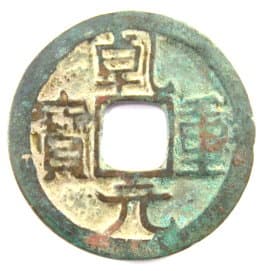
Shown at the left is a qian yuan zhong bao (乾元重寶) which was cast in 759 AD by Emperor Suzong (唐肅宗 756-762 AD) of the Tang dynasty.
This “zhong bao” coin was declared to be worth the equivalent of 10 regular cash coins such as the kai yuan tong bao.
While there are no historical records stating that a “kai yuan zhong bao” (開元重寶) was ever officially minted, shown below is such a coin.
The inscription is read in the traditional order (top, bottom, right, left). The coin is made of copper and is well-made. The characters are uniform but appear to be of slightly different sizes. The coin is 33 mm in diameter which makes it larger than a Tang dynasty coin which is about 24 mm.
This coin would not have been minted during the Tang dynasty but rather sometime later. At this time, it is not clear when or where the coin originated. The coin may be of Japanese origin, or even a charm, but it was not presented at the auction as either of these. This kai yuan zhong bao copper coin was sold at China Guardian Auctions in 2011 for about $925.
Even more unusual than the kai yuan zhong bao described above is the kai yuan zhong bao coin made of lead shown at the left.
The kai (開) at top, the yuan (元) at bottom and the zhong (重) at right can be clearly identified.
The bao (寶) at left is, however, very strange until you realize that it is not the Chinese character bao (寶).
Remember that the Chinese character bao (寶) translates as “treasure”.
The “character” to the left of the square hole in this lead kai yuan zhong bao coin is, in fact, not a Chinese character at all but rather a picture of an ingot.
Shown at the left is another form of ancient Chinese money known as an ingot (sycee 细丝). Sycee were made of either silver or gold and could be cast in a number of different shapes. The silver ingot (银锭) at the left is the most common and its shape would be easily recognizable by the Chinese people.
The ingot, being a very high denomination form of money, would therefore represent a “treasure” and easily substitutes for the Chinese character bao, meaning “treasure”, on this coin.
So, the inscription on the coin is indeed kai yuan zhong bao.
While it is not clear when or where the copper kai yuan zhong bao described above originated, it is much clearer where the lead coin came from since it was found in the same area as the State of Chu and Southern Han Kingdom lead coins discussed earlier.
Finally, I would like to introduce the most unusual variation of the “kai yuan” coin theme. It is another lead coin. It was also found in the same area as the other lead coins discussed above and, therefore, is also attributed to the State of Chu or the Southern Han Kingdom.
Looking at the coin above, you can clearly see from the rubbing that it has the kai (開) at the top, the yuan (元) at the bottom, and the tong (通) at the right.
But, you can also clearly see that the character at the left is zhong (重). This is the position where you would always expect to see the Chinese character bao (寶) meaning “treasure”.
This means that the inscription reads kai yuan tong zhong (開元通重) which makes no sense at all! Remember the tong (通) character signifies a one cash coin while coins with the zhong (重) character represent a higher denomination such as, for example, being worth 10 cash coins.
How could a coin be worth both 1 cash and 10 cash at the same time?
The owner of this coin believes that whoever made the coin mould was just careless and mistakenly wrote zhong (重) instead of bao (寶). We know that scribes can sometimes make mistakes in manuscripts so it is certainly possible that the same can happen to those writing the inscriptions in coin moulds.
It appears that after making the mould, no one noticed or cared about the error and coins were cast. It is likely that very few coins were produced from this one mould and, as far as is known, this is the only specimen to have survived to the present time.
The owner of the coin even speculates that this may be the earliest specimen of any Chinese coin having such a clerical error to have been discovered.
The coins described above are just a few of the more interesting and unusual examples of coins based on the Tang dynasty kai yuan tong bao to have been discovered.
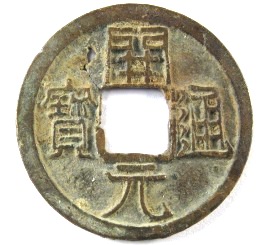
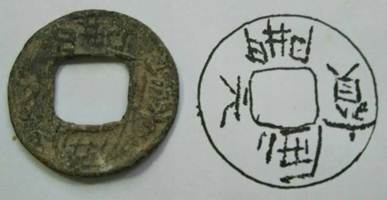




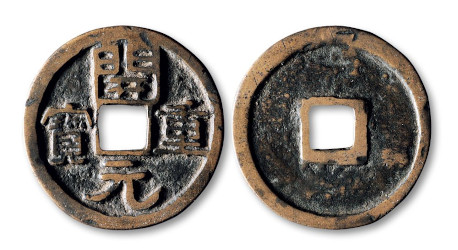

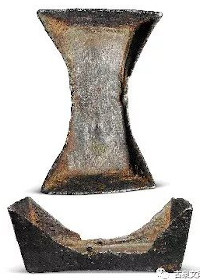
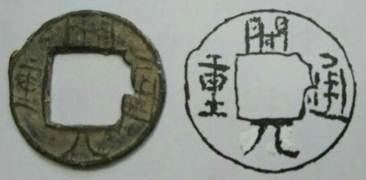
I wonder if the kai yuan tong zhong (開元通重) coin could possibly be a counterfeit. Sometimes counterfeiters change the inscriptions or details slightly so that they can claim they are not copying actual money. Also this reminds me of the American Colonial Granby copper tokens. These were originally designated as three pence, which was then altered to “value me as you please” which possibly parallels the 通重 inscription.
–Jim